Python CGI编程
什么是CGI
CGI 目前由NCSA维护,NCSA定义CGI如下:
CGI(Common Gateway Interface),通用网关接口,它是一段程序,运行在服务器上如:HTTP服务器,提供同客户端HTML页面的接口。
网页浏览
为了更好的了解CGI是如何工作的,我们可以从在网页上点击一个链接或URL的流程:
- 1、使用你的浏览器访问URL并连接到HTTP web 服务器。
- 2、Web服务器接收到请求信息后会解析URL,并查找访问的文件在服务器上是否存在,如果存在返回文件的内容,否则返回错误信息。
- 3、浏览器从服务器上接收信息,并显示接收的文件或者错误信息。
CGI程序可以是Python脚本,PERL脚本,SHELL脚本,C或者C++程序等。
CGI架构图
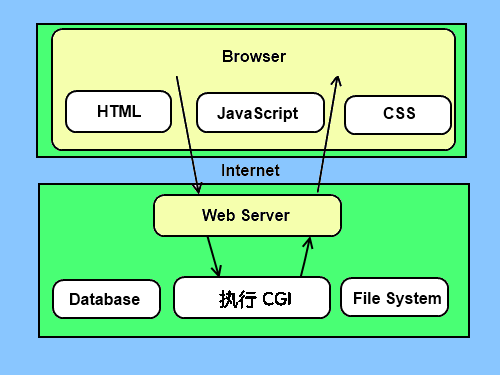
Web服务器支持及配置
在你进行CGI编程前,确保您的Web服务器支持CGI及已经配置了CGI的处理程序。
Apache 支持CGI 配置:
设置好CGI目录:
ScriptAlias /cgi-bin/ /var/www/cgi-bin/
所有的HTTP服务器执行CGI程序都保存在一个预先配置的目录。这个目录被称为CGI目录,并按照惯例,它被命名为/var/www/cgi-bin目录。
CGI文件的扩展名为.cgi,python也可以使用.py扩展名。
默认情况下,Linux服务器配置运行的cgi-bin目录中为/var/www。
如果你想指定其他运行CGI脚本的目录,可以修改httpd.conf配置文件,如下所示:
<Directory "/var/www/cgi-bin"> AllowOverride None Options +ExecCGI Order allow,deny Allow from all </Directory>
在 AddHandler 中添加 .py 后缀,这样我们就可以访问 .py 结尾的 python 脚本文件:
AddHandler cgi-script .cgi .pl .py
第一个CGI程序
我们使用Python创建第一个CGI程序,文件名为hello.py,文件位于/var/www/cgi-bin目录中,内容如下:
实例
print ( "Content-type:text/html" )
print ( ) # 空行,告诉服务器结束头部
print ( '<html>' )
print ( '<head>' )
print ( '<meta charset="utf-8">' )
print ( '<title>Hello Word - 我的第一个 CGI 程序!</title>' )
print ( '</head>' )
print ( '<body>' )
print ( '<h2>Hello Word! 我是来自云搜索MX教程的第一CGI程序</h2>' )
print ( '</body>' )
print ( '</html>' )
文件保存后修改 hello.py,修改文件权限为 755:
chmod 755 hello.py
以上程序在浏览器访问显示结果如下:
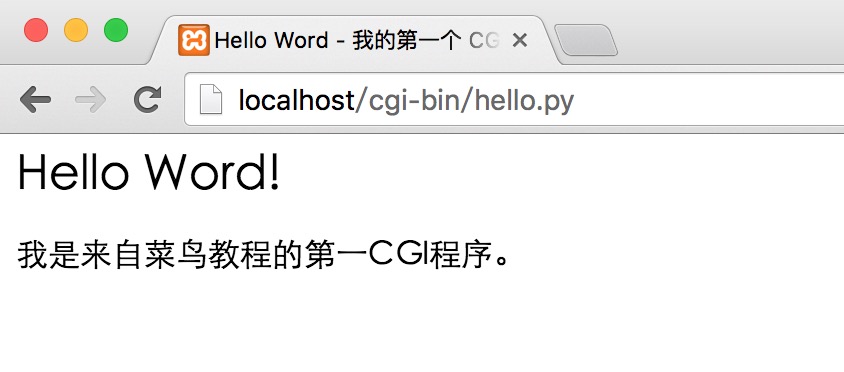
这个的hello.py脚本是一个简单的Python脚本,脚本第一行的输出内容"Content-type:text/html"发送到浏览器并告知浏览器显示的内容类型为"text/html"。
用 print 输出一个空行用于告诉服务器结束头部信息。
HTTP头部
hello.py文件内容中的" Content-type:text/html"即为HTTP头部的一部分,它会发送给浏览器告诉浏览器文件的内容类型。
HTTP头部的格式如下:
HTTP 字段名: 字段内容
例如:
Content-type: text/html
以下表格介绍了CGI程序中HTTP头部经常使用的信息:
| 头 | 描述 |
|---|---|
| Content-type: | 请求的与实体对应的MIME信息。例如: Content-type:text/html |
| Expires: Date | 响应过期的日期和时间 |
| Location: URL | 用来重定向接收方到非请求URL的位置来完成请求或标识新的资源 |
| Last-modified: Date | 请求资源的最后修改时间 |
| Content-length: N | 请求的内容长度 |
| Set-Cookie: String | 设置Http Cookie |
CGI环境变量
所有的CGI程序都接收以下的环境变量,这些变量在CGI程序中发挥了重要的作用:
| 变量名 | 描述 |
|---|---|
| CONTENT_TYPE | 这个环境变量的值指示所传递来的信息的MIME类型。目前,环境变量CONTENT_TYPE一般都是:application/x-www-form-urlencoded,他表示数据来自于HTML表单。 |
| CONTENT_LENGTH | 如果服务器与CGI程序信息的传递方式是POST,这个环境变量即使从标准输入STDIN中可以读到的有效数据的字节数。这个环境变量在读取所输入的数据时必须使用。 |
| HTTP_COOKIE | 客户机内的 COOKIE 内容。 |
| HTTP_USER_AGENT | 提供包含了版本数或其他专有数据的客户浏览器信息。 |
| PATH_INFO | 这个环境变量的值表示紧接在CGI程序名之后的其他路径信息。它常常作为CGI程序的参数出现。 |
| QUERY_STRING | 如果服务器与CGI程序信息的传递方式是GET,这个环境变量的值即使所传递的信息。这个信息经跟在CGI程序名的后面,两者中间用一个问号'?'分隔。 |
| REMOTE_ADDR | 这个环境变量的值是发送请求的客户机的IP地址,例如上面的192.168.1.67。这个值总是存在的。而且它是Web客户机需要提供给Web服务器的唯一标识,可以在CGI程序中用它来区分不同的Web客户机。 |
| REMOTE_HOST | 这个环境变量的值包含发送CGI请求的客户机的主机名。如果不支持你想查询,则无需定义此环境变量。 |
| REQUEST_METHOD | 提供脚本被调用的方法。对于使用 HTTP/1.0 协议的脚本,仅 GET 和 POST 有意义。 |
| SCRIPT_FILENAME | CGI脚本的完整路径 |
| SCRIPT_NAME | CGI脚本的的名称 |
| SERVER_NAME | 这是你的 WEB 服务器的主机名、别名或IP地址。 |
| SERVER_SOFTWARE | 这个环境变量的值包含了调用CGI程序的HTTP服务器的名称和版本号。例如,上面的值为Apache/2.2.14(Unix) |
以下是一个简单的CGI脚本输出CGI的环境变量:
实例
import os
print ( "Content-type: text/html" )
print ( )
print ( "<meta charset=\" utf-8 \" >" )
print ( "<b>环境变量</b><br>" )
print ( "<ul>" )
for key in os . environ . keys ( ) :
print ( "<li><span style='color:green'>%30s </span> : %s </li>" % ( key , os . environ [ key ] ) )
print ( "</ul>" )
将以上点保存为 test.py ,并修改文件权限为 755,执行结果如下:

GET和POST方法
浏览器客户端通过两种方法向服务器传递信息,这两种方法就是 GET 方法和 POST 方法。
使用GET方法传输数据
GET方法发送编码后的用户信息到服务端,数据信息包含在请求页面的URL上,以"?"号分割, 如下所示:
http://www.test.com/cgi-bin/hello.py?key1=value1&key2=value2有关 GET 请求的其他一些注释:
- GET 请求可被缓存
- GET 请求保留在浏览器历史记录中
- GET 请求可被收藏为书签
- GET 请求不应在处理敏感数据时使用
- GET 请求有长度限制
- GET 请求只应当用于取回数据
简单的url实例:GET方法
以下是一个简单的URL,使用GET方法向hello_get.py程序发送两个参数:
/cgi-bin/test.py?name=云搜索MX教程&url=http://www.yssmx.com
以下为 hello_get.py 文件的代码:
实例
# CGI处理模块
import cgi , cgitb
# 创建 FieldStorage 的实例化
form = cgi . FieldStorage ( )
# 获取数据
site_name = form. getvalue ( 'name' )
site_url = form. getvalue ( 'url' )
print ( "Content-type:text/html" )
print ( )
print ( "<html>" )
print ( "<head>" )
print ( "<meta charset=\" utf-8 \" >" )
print ( "<title>云搜索MX教程 CGI 测试实例</title>" )
print ( "</head>" )
print ( "<body>" )
print ( "<h2>%s官网:%s</h2>" % ( site_name , site_url ) )
print ( "</body>" )
print ( "</html>" )
文件保存后修改 hello_get.py,修改文件权限为 755:
chmod 755 hello_get.py
浏览器请求输出结果:

简单的表单实例:GET方法
以下是一个通过HTML的表单使用GET方法向服务器发送两个数据,提交的服务器脚本同样是hello_get.py文件,hello_get.html 代码如下:
实例
< html >
< head >
< meta charset = "utf-8" >
< title > 云搜索MX教程(yssmx.com) < / title >
< / head >
< body >
< form action = "/cgi-bin/hello_get.py" method = "get" >
站点名称: < input type = "text" name = "name" > < br / >
站点 URL: < input type = "text" name = "url" / >
< input type = "submit" value = "提交" / >
< / form >
< / body >
< / html >
默认情况下 cgi-bin 目录只能存放脚本文件,我们将 hello_get.html 存储在 test 目录下,修改文件权限为 755:
chmod 755 hello_get.html
Gif 演示如下所示:
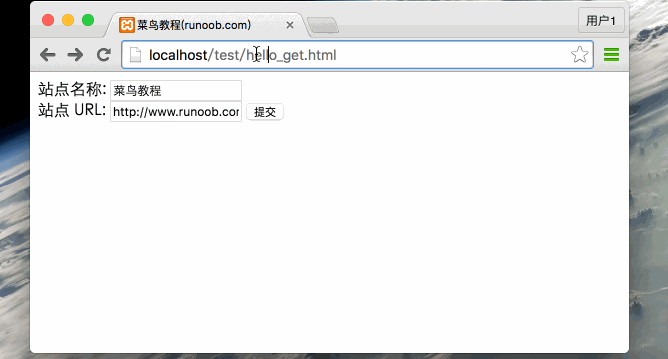
使用POST方法传递数据
使用POST方法向服务器传递数据是更安全可靠的,像一些敏感信息如用户密码等需要使用POST传输数据。
以下同样是hello_get.py ,它也可以处理浏览器提交的POST表单数据:
实例
# CGI处理模块
import cgi , cgitb
# 创建 FieldStorage 的实例化
form = cgi . FieldStorage ( )
# 获取数据
site_name = form. getvalue ( 'name' )
site_url = form. getvalue ( 'url' )
print ( "Content-type:text/html" )
print ( )
print ( "<html>" )
print ( "<head>" )
print ( "<meta charset=\" utf-8 \" >" )
print ( "<title>云搜索MX教程 CGI 测试实例</title>" )
print ( "</head>" )
print ( "<body>" )
print ( "<h2>%s官网:%s</h2>" % ( site_name , site_url ) )
print ( "</body>" )
print ( "</html>" )
以下为表单通过POST方法( method="post" )向服务器脚本 hello_get.py 提交数据:
实例
< html >
< head >
< meta charset = "utf-8" >
< title > 云搜索MX教程(yssmx.com) < / title >
< / head >
< body >
< form action = "/cgi-bin/hello_get.py" method = "post" >
站点名称: < input type = "text" name = "name" > < br / >
站点 URL: < input type = "text" name = "url" / >
< input type = "submit" value = "提交" / >
< / form >
< / body >
< / html >
< / form >
Gif 演示如下所示:
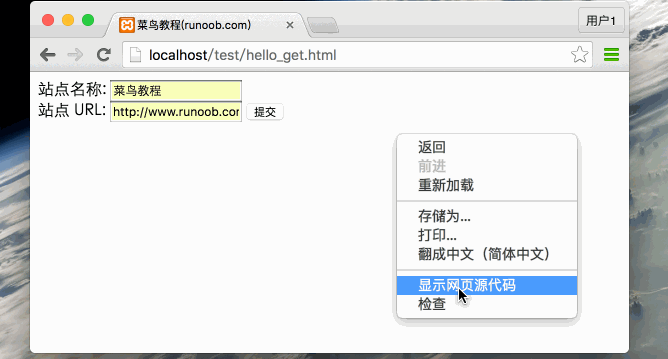
通过CGI程序传递checkbox数据
checkbox用于提交一个或者多个选项数据,HTML代码如下:
实例
< html >
< head >
< meta charset = "utf-8" >
< title > 云搜索MX教程(yssmx.com) < / title >
< / head >
< body >
< form action = "/cgi-bin/checkbox.py" method = "POST" target = "_blank" >
< input type = "checkbox" name = "yssmx" value = "on" / > 云搜索MX教程
< input type = "checkbox" name = "google" value = "on" / > Google
< input type = "submit" value = "选择站点" / >
< / form >
< / body >
< / html >
以下为 checkbox.py 文件的代码:
实例
# 引入 CGI 处理模块
import cgi , cgitb
# 创建 FieldStorage的实例
form = cgi . FieldStorage ( )
# 接收字段数据
if form. getvalue ( 'google' ) :
google_flag = "是"
else :
google_flag = "否"
if form. getvalue ( 'yssmx' ) :
yssmx_flag = "是"
else :
yssmx_flag = "否"
print ( "Content-type:text/html" )
print ( )
print ( "<html>" )
print ( "<head>" )
print ( "<meta charset=\" utf-8 \" >" )
print ( "<title>云搜索MX教程 CGI 测试实例</title>" )
print ( "</head>" )
print ( "<body>" )
print ( "<h2> 云搜索MX教程是否选择了 : %s</h2>" % yssmx_flag )
print ( "<h2> Google 是否选择了 : %s</h2>" % google_flag )
print ( "</body>" )
print ( "</html>" )
修改 checkbox.py 权限:
chmod 755 checkbox.py
浏览器访问 Gif 演示图:
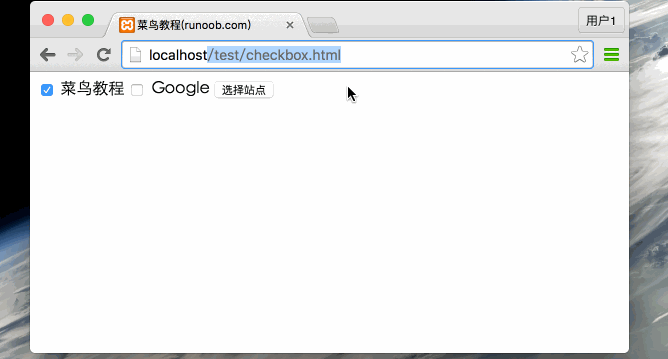
通过CGI程序传递Radio数据
Radio 只向服务器传递一个数据,HTML代码如下:
实例
< html >
< head >
< meta charset = "utf-8" >
< title > 云搜索MX教程(yssmx.com) < / title >
< / head >
< body >
< form action = "/cgi-bin/radiobutton.py" method = "post" target = "_blank" >
< input type = "radio" name = "site" value = "yssmx" / > 云搜索MX教程
< input type = "radio" name = "site" value = "google" / > Google
< input type = "submit" value = "提交" / >
< / form >
< / body >
< / html >
radiobutton.py 脚本代码如下:
实例
# 引入 CGI 处理模块
import cgi , cgitb
# 创建 FieldStorage的实例
form = cgi . FieldStorage ( )
# 接收字段数据
if form. getvalue ( 'site' ) :
site = form. getvalue ( 'site' )
else :
site = "提交数据为空"
print ( "Content-type:text/html" )
print ( )
print ( "<html>" )
print ( "<head>" )
print ( "<meta charset=\" utf-8 \" >" )
print ( "<title>云搜索MX教程 CGI 测试实例</title>" )
print ( "</head>" )
print ( "<body>" )
print ( "<h2> 选中的网站是 %s</h2>" % site )
print ( "</body>" )
print ( "</html>" )
修改 radiobutton.py 权限:
chmod 755 radiobutton.py
浏览器访问 Gif 演示图:
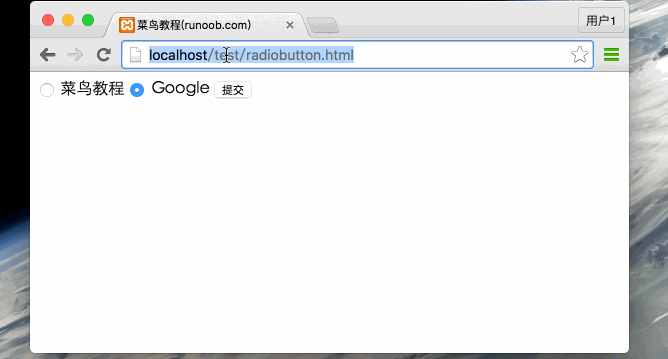
通过CGI程序传递 Textarea 数据
Textarea 向服务器传递多行数据,HTML 代码如下:
实例
< html >
< head >
< meta charset = "utf-8" >
< title > 云搜索MX教程(yssmx.com) < / title >
< / head >
< body >
< form action = "/cgi-bin/textarea.py" method = "post" target = "_blank" >
< textarea name = "textcontent" cols = "40" rows = "4" >
在这里输入内容...
< / textarea >
< input type = "submit" value = "提交" / >
< / form >
< / body >
< / html >
textarea.py 脚本代码如下:
实例
# 引入 CGI 处理模块
import cgi , cgitb
# 创建 FieldStorage的实例
form = cgi . FieldStorage ( )
# 接收字段数据
if form. getvalue ( 'textcontent' ) :
text_content = form. getvalue ( 'textcontent' )
else :
text_content = "没有内容"
print ( "Content-type:text/html" )
print ( )
print ( "<html>" )
print ( "<head>" )
print ( "<meta charset=\" utf-8 \" >" )
print ( "<title>云搜索MX教程 CGI 测试实例</title>" )
print ( "</head>" )
print ( "<body>" )
print ( "<h2> 输入的内容是:%s</h2>" % text_content )
print ( "</body>" )
print ( "</html>" )
修改 textarea.py 权限:
chmod 755 textarea.py
浏览器访问 Gif 演示图:
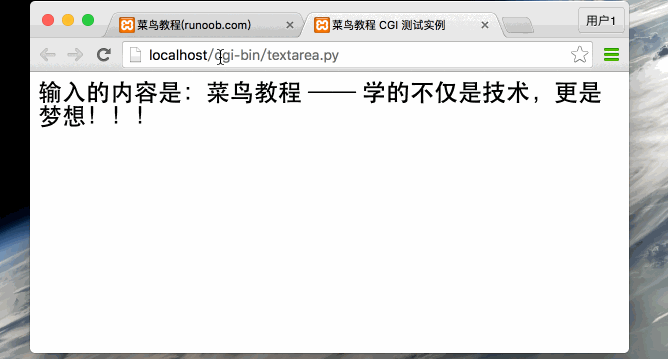
通过CGI程序传递下拉数据。
HTML 下拉框代码如下:
实例
< html >
< head >
< meta charset = "utf-8" >
< title > 云搜索MX教程(yssmx.com) < / title >
< / head >
< body >
< form action = "/cgi-bin/dropdown.py" method = "post" target = "_blank" >
< select name = "dropdown" >
< option value = "yssmx" selected> 云搜索MX教程 < / option >
< option value = "google" > Google < / option >
< / select >
< input type = "submit" value = "提交" / >
< / form >
< / body >
< / html >
dropdown.py 脚本代码如下所示:
实例
# 引入 CGI 处理模块
import cgi , cgitb
# 创建 FieldStorage的实例
form = cgi . FieldStorage ( )
# 接收字段数据
if form. getvalue ( 'dropdown' ) :
dropdown_value = form. getvalue ( 'dropdown' )
else :
dropdown_value = "没有内容"
print ( "Content-type:text/html" )
print ( )
print ( "<html>" )
print ( "<head>" )
print ( "<meta charset=\" utf-8 \" >" )
print ( "<title>云搜索MX教程 CGI 测试实例</title>" )
print ( "</head>" )
print ( "<body>" )
print ( "<h2> 选中的选项是:%s</h2>" % dropdown_value )
print ( "</body>" )
print ( "</html>" )
修改 dropdown.py 权限:
chmod 755 dropdown.py
浏览器访问 Gif 演示图:
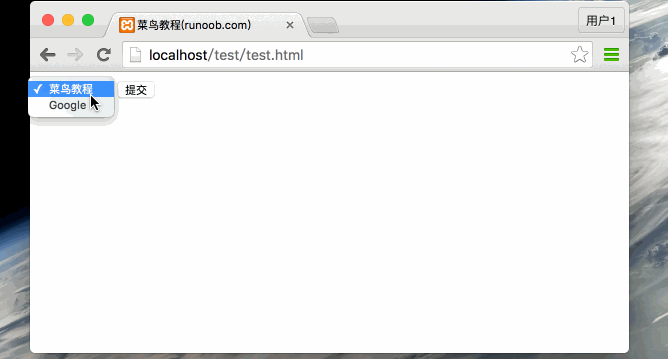
CGI中使用Cookie
在 http 协议一个很大的缺点就是不对用户身份的进行判断,这样给编程人员带来很大的不便, 而 cookie 功能的出现弥补了这个不足。
cookie 就是在客户访问脚本的同时,通过客户的浏览器,在客户硬盘上写入纪录数据 ,当下次客户访问脚本时取回数据信息,从而达到身份判别的功能,cookie 常用在身份校验中。
cookie的语法
http cookie的发送是通过http头部来实现的,他早于文件的传递,头部set-cookie的语法如下:
Set-cookie:name=name;expires=date;path=path;domain=domain;secure
- name=name: 需要设置cookie的值(name不能使用" ; "和" , "号),有多个name值时用 " ; " 分隔,例如: name1=name1;name2=name2;name3=name3。
- expires=date: cookie的有效期限,格式: expires="Wdy,DD-Mon-YYYY HH:MM:SS"
- path=path: 设置cookie支持的路径,如果path是一个路径,则cookie对这个目录下的所有文件及子目录生效,例如: path="/cgi-bin/",如果path是一个文件,则cookie指对这个文件生效,例如:path="/cgi-bin/cookie.cgi"。
- domain=domain: 对cookie生效的域名,例如:domain="www.yssmx.com"
- secure: 如果给出此标志,表示cookie只能通过SSL协议的https服务器来传递。
- cookie的接收是通过设置环境变量HTTP_COOKIE来实现的,CGI程序可以通过检索该变量获取cookie信息。
Cookie设置
Cookie的 设置非常简单,cookie 会在 http 头部单独发送。以下实例在 cookie 中设置了 name 和 expires:
实例
print ( 'Set-Cookie: name="云搜索MX教程";expires=Wed, 28 Aug 2016 18:30:00 GMT' )
print ( 'Content-Type: text/html' )
print ( )
print ( """
<html>
<head>
<meta charset="utf-8">
<title>云搜索MX教程(yssmx.com)</title>
</head>
<body>
<h1>Cookie set OK!</h1>
</body>
</html>
""" )
将以上代码保存到 cookie_set.py,并修改 cookie_set.py 权限:
chmod 755 cookie_set.py
以上实例使用了 Set-Cookie 头信息来设置 Cookie 信息,可选项中设置了 Cookie 的其他属性,如过期时间 Expires,域名 Domain,路径 Path。这些信息设置在 "Content-type:text/html" 之前。
检索Cookie信息
Cookie信息检索页非常简单,Cookie信息存储在CGI的环境变量HTTP_COOKIE中,存储格式如下:
key1=value1;key2=value2;key3=value3....
以下是一个简单的CGI检索cookie信息的程序:
实例
# 导入模块
import os
import http. cookies
print ( "Content-type: text/html" )
print ( )
print ( """
<html>
<head>
<meta charset="utf-8">
<title>云搜索MX教程(yssmx.com)</title>
</head>
<body>
<h1>读取cookie信息</h1>
""" )
if 'HTTP_COOKIE' in os . environ :
cookie_string = os . environ . get ( 'HTTP_COOKIE' )
c = http. cookies . SimpleCookie ( )
# c=Cookie.SimpleCookie()
c. load ( cookie_string )
try :
data = c [ 'name' ] . value
print ( "cookie data: " +data+ "<br>" )
except KeyError :
print ( "cookie 没有设置或者已过去<br>" )
print ( """
</body>
</html>
""" )
将以上代码保存到 cookie_get.py,并修改 cookie_get.py 权限:
chmod 755 cookie_get.py
以上 cookie 设置演示 Gif 如下所示:
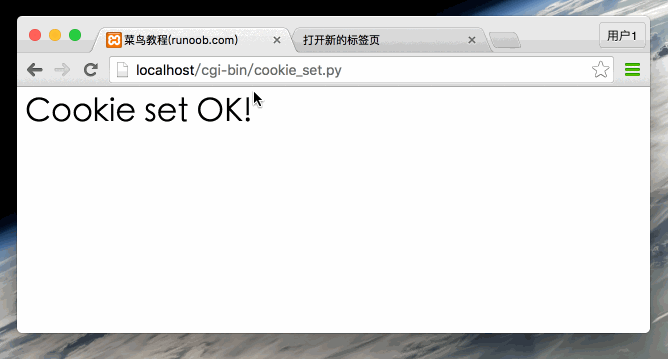
文件上传实例
HTML设置上传文件的表单需要设置 enctype 属性为 multipart/form-data ,代码如下所示:
实例
< html >
< head >
< meta charset = "utf-8" >
< title > 云搜索MX教程(yssmx.com) < / title >
< / head >
< body >
< form enctype = "multipart/form-data"
action = "/cgi-bin/save_file.py" method = "post" >
< p > 选中文件: < input type = "file" name = "filename" / >< / p >
< p >< input type = "submit" value = "上传" / >< / p >
< / form >
< / body >
< / html >
save_file.py 脚本文件代码如下:
实例
import cgi , os
import cgitb ; cgitb . enable ( )
form = cgi . FieldStorage ( )
# 获取文件名
fileitem = form [ 'filename' ]
# 检测文件是否上传
if fileitem. filename :
# 设置文件路径
fn = os . path . basename ( fileitem. filename )
open ( '/tmp/' + fn , 'wb' ) . write ( fileitem. file . read ( ) )
message = '文件 "' + fn + '" 上传成功'
else :
message = '文件没有上传'
print ( """ \
Content-Type: text/html \n
<html>
<head>
<meta charset="utf-8">
<title>云搜索MX教程(yssmx.com)</title>
</head>
<body>
<p>%s</p>
</body>
</html>
""" % ( message , ) )
将以上代码保存到 save_file.py,并修改 save_file.py 权限:
chmod 755 save_file.py
以上 cookie 设置演示 Gif 如下所示:
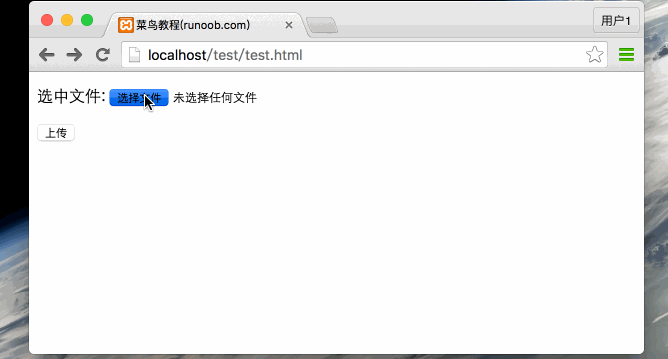
如果你使用的系统是Unix/Linux,你必须替换文件分隔符,在window下只需要使用open()语句即可:
fn = os.path.basename(fileitem.filename.replace("\\", "/" ))
文件下载对话框
我们先在当前目录下创建 foo.txt 文件,用于程序的下载。
文件下载通过设置HTTP头信息来实现,功能代码如下:
实例
# HTTP 头部
print ( "Content-Disposition: attachment; filename=\" foo.txt \" " )
print ( )
# 打开文件
fo = open ( "foo.txt" , "rb" )
str = fo. read ( ) ;
print ( str )
# 关闭文件
fo. close ( )
